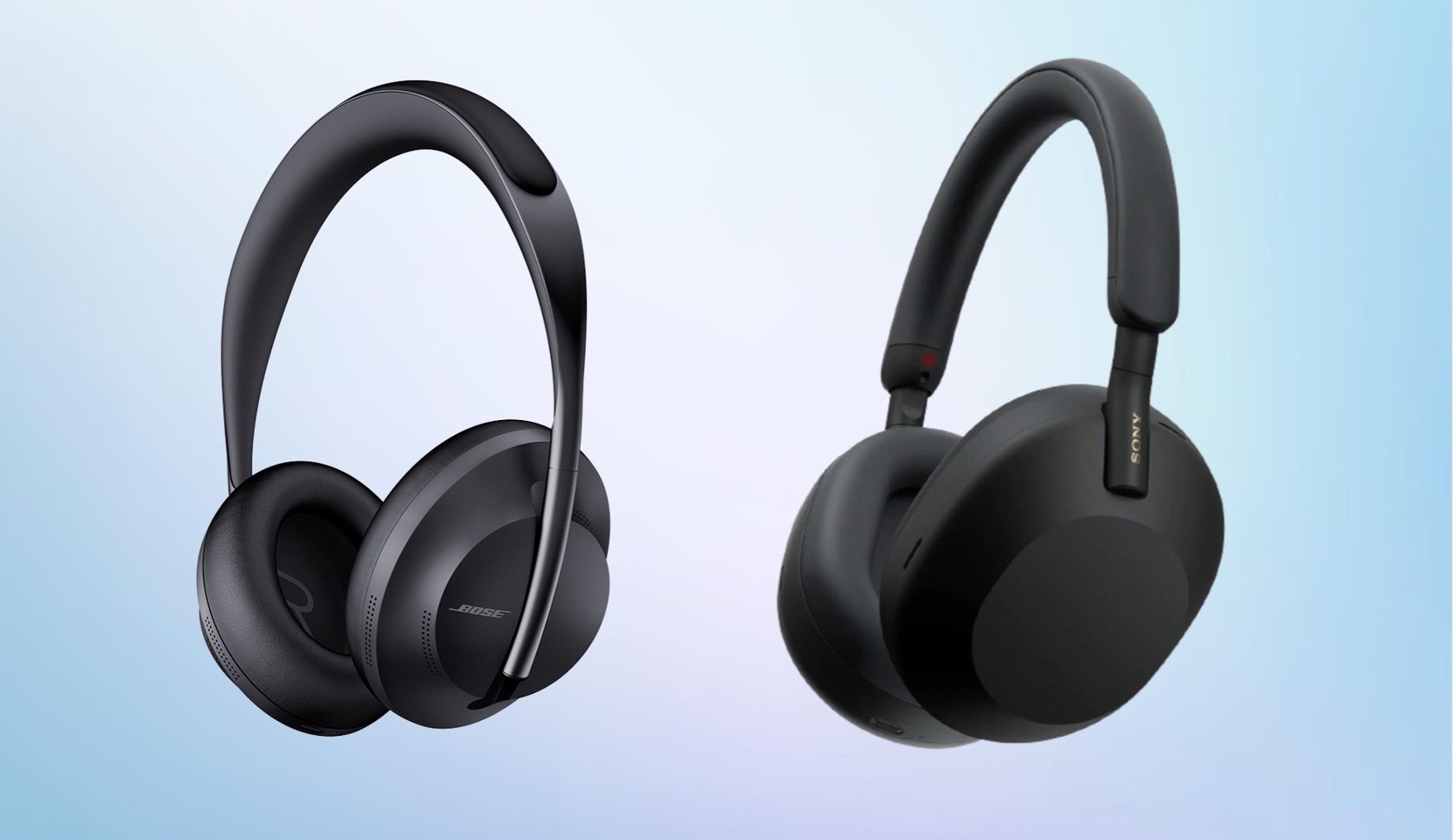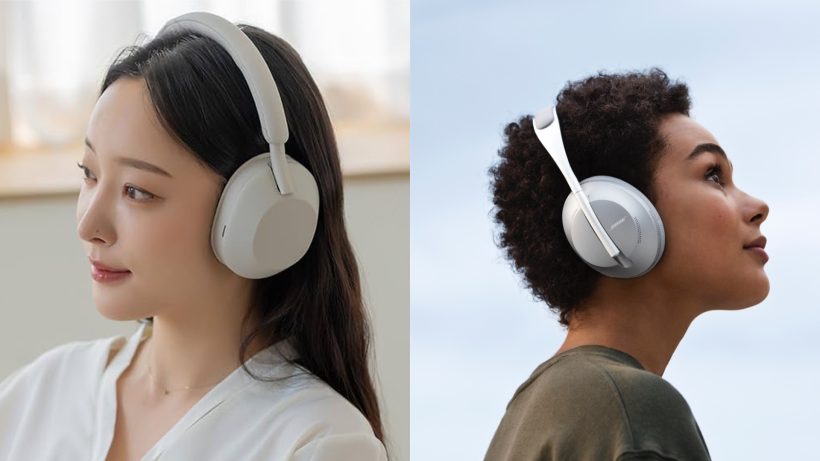The Sony WH-1000XM5 and the Bose 700 headphones are top-tier noise cancelling headphones that are designed to deliver powerful noise cancellation and really good sound performance. The Sony WH-1000XM5 headphone is specially designed with a 30mm driver unit with a carbon fiber composite that improves sound clarity especially in the higher frequency ranges. The Sony headphone is one of the most advanced ANC headphones currently available and uses two ANC processors to control 8 microphones for better noise cancellation. It also supports automatic noise cancelling optimization which automatically optimizes the sound based on your surrounding environment. The WH-1000XM5 also comes with a new integrated processor V1 which provides very fast frequency response and advanced audio signal processing. Like the Bose 700, the WH-1000XM5 headphone also comes with intuitive touch control settings which allow you to pause or skip soundtracks, control volume and answer phone calls on the go. It suffices to say that the Sony WH-1000XM5s are the most advanced noise cancelling headphones developed by Sony to date.
The Bose 700 headphones are older than the WH-1000XM5 headphones but they also deliver pretty good noise cancellation. This headphone is capable of providing 11 levels of active noise cancellation and provides more customization options. The Bose 700 comes with a high-performance driver that delivers crisp highs and crystal clear details for lifelike and balanced sound. The Bose 700 comes with a lightweight stainless steel headband with titled earcups for a quiet listening experience, and it comes with a built-in battery that delivers up to 20 hours of playtime on a single charge. Throughout our tests, we would say that the Bose 700 headphones have some of the best microphone call quality and it picks up your voice without any interference from background noise.

Comparing the Specs
| Specification | Bose 700 | Sony WH-1000XM5 |
|---|---|---|
| Type | Around Ear, Circumaural | Closed, Dynamic |
| Weight | 8.82 oz (250 g) | 8.82 oz (250 g) |
| Microphones | 8 Microphones (4 for Voice, 6 for ANC) | 8 Microphones for Noise Cancellation |
| Noise Cancelling | Active Noise Cancelling | Active Noise Cancelling |
| Battery Life | 20 hours | Max. 30 hrs (NC ON), Max. 40 hrs (NC OFF) |
| Charge Time | 2.5 hours | Approx. 3.5 hrs |
| Wireless Connectivity | AAC, SBC Bluetooth | SBC, AAC, LDAC |
| Bluetooth Version | 5.0 | 5.2 |
| Bluetooth Range | Up to 33 feet (10 meters) | Line of sight approx. 30 ft (10 m) |
| Frequency Response (Bluetooth) | Not specified | 20 Hz–20,000 Hz (44.1 kHz Sampling), 20 Hz–40,000 Hz (LDAC 96 kHz Sampling, 990 kbps) |
| Audio cable included | Yes | Yes |
| Charging Interface | USB-C | USB |
| App Support | Bose Music App | Sony |
The Sony WH-1000XM5s have much better battery capacity as compared to the Bose 700. Perhaps the biggest difference is that the Sony WH-1000XM5s support LDAC codec for high-resolution audio streaming, which can make a big difference in audio performance as LDAC greatly enhances the detail in the music.
Sound Comparison
In terms of sound performance, we would say that the Sony WH-1000XM5 has a more bass-leaning sound signature which makes it more entertaining to listen to especially if you listen to EDM or live music soundtracks. The WH-1000XM5 tends to have a bass-heavier default EQ, while the Bose 700 is more neutral and balanced. Both sets of headphones allow you to adjust the EQ settings through the Bose or Sony headphone app. The WH-1000XM5 delivers balanced mid-range, clear vocals, and instrumentation, while the Bose 700 excels in midrange accuracy. In terms of treble, the WH-1000XM5 offers clarity without harshness, and the Bose 700, although slightly recessed in treble, provides good detail and instrumentation separation.
Generally speaking, we felt that the Sony WH-1000XM5s outperformed the Bose 700 in terms of bass and vocal clarity. EDM music performances sounded really punchy and tight with very little distortion at high volume levels, and you get a lot of detail in the music particularly at the vocal ranges. Ed Sheeran’s “Shape of you” sounded much more engaging on the WH-1000XM5 with better bass response and punchy beats with plenty of depth, and we enjoyed the vocals and upper frequency ranges which were more detailed and articulated on the Sony WH-1000XM5s.
The Bose 700, by contrast, delivered a more well-balanced sound signature with nice highs and decent bass, but is nowhere close to the deep bass that the WH-1000XM5s can deliver with full ANC switched on. Tony Bennett’s “Fly me to the moon” sounded really nice on the Bose 700 with good soundstage and separation, and you can hear the midrange particularly well on the Bose 700. We would say that the Bose 700 is more suited for those who want to listen to a wide variety of music genres and get a more well-balanced sound signature. Personally, we preferred the Sony WH-1000XM5s because these headphones have more bass and are more engaging to listen to, while the Bose 700 is a more neutral sounding headphone.

Noise Cancelling Comparison
The Sony WH-1000XM5 is particularly efficient at blocking both low and high frequencies, making it ideal for frequent travellers or those working in noisy environments. The Bose 700 also performs well in noise-cancelling but doesn’t quite match the efficacy of the WH-1000XM5 in blocking background noise. Both models offer a transparency mode, allowing users to hear ambient sounds when necessary. The Sony WH-1000XM5 is an all-round much better noise cancelling headphone than the Bose 700, and is able to effectively block background sounds including conversational speech. To give an example, the noise of fan that is placed 3m away from you will sound one-eighth as loud on the WH-1000XM5 and one-fourth as loud on the Bose 700 headphone.
The Sony WH-1000XM5 allows you to manually toggle between noise cancelling and ambient mode to let sound in (or transparency mode). The noise cancellation mode is not manually adjustable like the Bose 700, although the headphone itself will automatically calibrate the noise and adjust the noise cancellation accordingly. We did find however that you can adjust the amount of ambient sound you want inside the Sony WH-1000XM5 headphone. At it’s highest setting, we found that the WH-1000XM5 not only lets background sound in but it also augments the sounds from your surroundings so that you can hear them more clearly.
Although the Bose 700 headphone’s noise cancelling is not as effective or efficient as the Sony WH-1000XM5 headphone, it supports 11 levels of ANC which we found to be quite useful especially if you want to control the amount of noise cancellation. This can be useful if you want to hear your surroundings partially but still have some level of noise cancellation; the Sony WH-1000XM5s only have two modes which are ambient or full ANC, and you cannot manually select the ANC levels on the WH-1000XM5.

Design and Specs
The Sony WH-1000XM5, while slightly lighter than the Bose 700, is a much more portable headphone with a foldable design. The Bose 700, weighing just a bit more, is generally more comfortable due to its substantial padding on the headband and earpads and provides more comfort for extended listening sessions. Both models have a modern appearance, with the WH-1000XM5 featuring a strong plastic material for a premium look, and the Bose 700 combining a metallic headband with luxurious padding on the headband and earcups. Both headphones have touch controls on their earcups and come with hard cases, although the case of the WH-1000XM5 looks more sophisticated.
In terms of battery life, the Sony WH-1000XM5 has an edge with quicker charging capabilities. It offers 3 hours of battery life with just a 3-minute charge, compared to the Bose 700, which provides 3.5 hours of battery life with a 15-minute charge. Both headphones use USB Type-C charging ports. On a full charge, both the Sony WH-1000XM5 and the Bose 700 delivers up to 20 hours of playtime.
The WH-1000XM5 provides on-ear detection, which automatically pauses music when you remove the headphones, a feature lacking in the Bose 700. The Sony headphones also have an ability to detect when you start talking and pause the music to let in ambient sound. However, the app for the WH-1000XM5 can be slightly daunting to use due to its numerous features and settings – we found the Bose app much easier and intuitive to use. The Sony WH-1000XM5 app however does provide much more EQ customization and adjustment options if you use it fully.
The Verdict?
The Sony WH-1000XM5 edges out the Bose 700 in terms of noise cancelling and sound performance. We found the noise cancelling on the Sony WH-1000XM5 headphone much more efficient and effective at blocking background noises than the Bose 700, and can effectively reduce high frequencies such as speech or conversational sounds. If you are thinking of getting a headphone purely for effective noise cancellation, the Sony WH-1000XM5 would definitely be a better choice than the Bose 700 (although the WH-1000XM5 does not give you the option of manually adjusting the ANC like the Bose 700).
In terms of sound quality, the Sony WH-1000XM5 has a more engaging sound signature with deeper bass and brighter highs, while the Bose 700 focuses on the midrange performance. This means that EDM, rock and hip-hop music genres perform better on the WH-1000XM5s and indeed in our own tests, the WH-1000XM5 deliver a much more engaging sound signature than the Bose 700. We would say that the Bose 700 has a more neutral sound signature (although we wouldn’t go to the extent to say that it is flat), with a focus on the midrange. The Bose 700 is more suitable for those who want a more well-balanced sound signature for easy listening and they perform well for instrumental music.
Overall, we would recommend the Sony WH-1000XM5 headphones over the Bose 700 due to its more advanced noise cancelling features and its lightweight (249g) and comfortable design.

